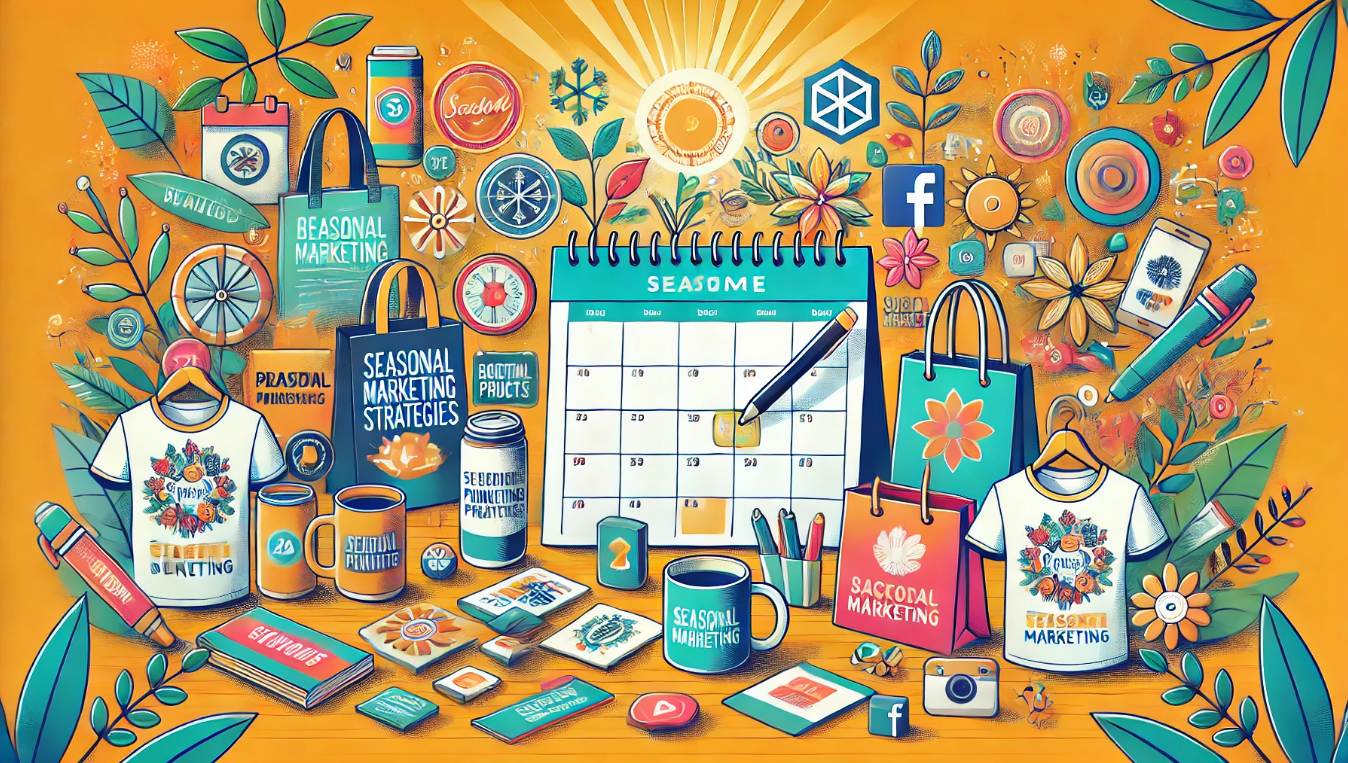
Leveraging seasonal marketing strategies can significantly enhance your brand’s visibility and boost sales. Utilizing promotional products tailored to each season not only reinforces your marketing efforts but also creates lasting impressions with your audience. This guide explores key seasonal marketing strategies, emphasizing early planning, targeted campaigns, and the effective use of promotional products to maximize your marketing impact.
The importance of seasonal marketing through promotional products.
Seasonal marketing allows businesses to align their promotional efforts with specific times of the year, holidays, and events that resonate with their target audience. Integrating promotional products into these campaigns allows companies to:
Increase Brand Visibility: Tangible items keep your brand in front of customers long after the campaign ends.
Enhance Customer Loyalty: Thoughtful gifts foster a positive relationship between your brand and customers.
Boost Sales: Seasonal promotions can drive urgency and encourage purchases during peak times.
Key Seasonal Marketing Strategies
1. Early Planning and Anticipation
Proactive Strategy Development
Planning your seasonal marketing campaigns 2-3 months in advance is crucial for building excitement and ensuring timely execution. Early planning allows you to strategize effectively and allocate resources efficiently.
Building Anticipation Through Teasers
Push Notifications & Emails: Send sneak peeks of upcoming promotions to your subscriber list. Personalized messages can increase engagement and anticipation.
Social Media Campaigns: Utilize social media platforms to share teasers, countdowns, and behind-the-scenes content. Engaging visuals and interactive posts can generate buzz and keep your audience interested.
Pre-Promotion Campaigns
Creating pre-promotion campaigns helps generate excitement before the official launch. Consider the following tactics:
Exclusive Previews: Offer loyal customers early access to new seasonal products.
Contests and Giveaways: Host themed contests that encourage user participation and expand your reach through sharing and engagement.
2. Identifying Priority Seasons
Comprehensive Marketing Calendar
Developing a detailed marketing calendar ensures that your promotional efforts are aligned with key seasonal opportunities. Include the following components in your calendar:
Major Holidays: Incorporate widely celebrated holidays such as Christmas, Thanksgiving, Valentine’s Day, and others relevant to your market.
Industry-Specific Events: Identify events specific to your industry, such as trade shows, product launches, or anniversaries.
Seasonal Changes: Align promotions with natural seasonal shifts like spring-cleaning, summer vacations, fall back-to-school, and winter holidays.
Local Festivities: Tailor campaigns to include regional events and traditions, enhancing local relevance and engagement.
Ranking and Prioritizing Seasons
Not all seasons offer the same potential for every business. Prioritize your seasonal marketing efforts based on:
Potential Business Impact: Assess which seasons are likely to drive the highest revenue or brand exposure.
Audience Relevance: Ensure that your seasonal focus aligns with your target audience’s preferences and behaviours.
Sales Opportunities: Identify periods with heightened purchasing intent and tailor promotions to capitalize on these opportunities.
3. Targeted Campaign Approaches
Tailoring Promotions to Each Season
Creating seasonal campaigns that resonate with specific audience segments is essential for maximizing impact. Here are tailored approaches for each season:
Fall: Back-to-School Offers & Halloween Specials
Promotional Products: Custom stationery, backpacks, Halloween-themed merchandise.
Marketing Tactics: Leverage the excitement of new beginnings and the festive spirit of Halloween to connect with students, parents, and communities.
Winter: Cozy Product Collections & Holiday Gift Campaigns
Promotional Products: Warm apparel, holiday-themed gadgets, personalized gifts.
Marketing Tactics: Emphasize comfort, togetherness, and the spirit of giving to appeal to consumers during the holiday season.
Spring: Spring-Cleaning Promotions & Renewal-Themed Marketing
Promotional Products: Eco-friendly products, organizers, gardening tools.
Marketing Tactics: Highlight rejuvenation, freshness, and sustainability to attract customers looking to refresh their lives and spaces.
Summer: Seasonal Product Launches & Vacation-Related Offerings
Promotional Products: Travel accessories, outdoor gear, summer apparel.
Marketing Tactics: Focus on adventure, relaxation, and fun to engage consumers planning vacations and outdoor activities.
Leveraging Promotional Products Effectively
Promotional products are powerful tools that can enhance your seasonal marketing efforts. To maximize their effectiveness, consider the following:
Choosing the Right Promotional Products
Relevance: Select items that align with the season and your target audience’s needs. For example, eco-friendly products for spring or travel accessories for summer.
Quality: High-quality products reflect positively on your brand and encourage long-term use, increasing brand exposure.
Utility: Choose items that serve a practical purpose, ensuring they are appreciated and retained by recipients.
Personalization and Branding
Customizing promotional products with your brand’s logo, colours, and messaging ensures that your brand remains top-of-mind. Personalized items create a more intimate connection with customers, fostering loyalty and advocacy.
Tips for Optimizing Your Seasonal Marketing Strategy
Stay Updated: Keep abreast of upcoming holidays, events, and trends relevant to your industry.
Be Creative: Think outside the box when selecting promotional products and designing campaigns to stand out from competitors.
Engage Your Audience: Encourage customer participation through interactive campaigns, such as contests and giveaways.
Analyze Competitors: Observe what your competitors are doing and identify opportunities to differentiate your campaigns.
Utilize Data: Leverage customer data and analytics to personalize your marketing efforts and better meet your audience’s needs.


